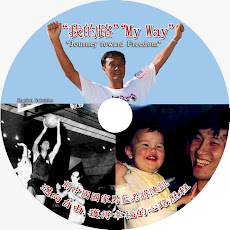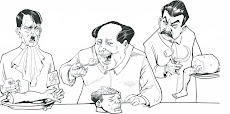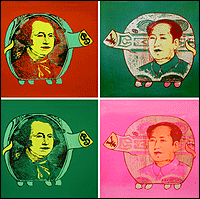

Kennedy-Reagan v. Bush-Obama 肯尼迪,里根 vs. 布什,奥巴马
By Peter Ferrara on 4.8.09 @ 6:08AM
"We tried that, and it didn't work," Obama and his partisans sneer in response to arguments that tax cuts are the key to restoring economic growth. Instead they support an economic recovery plan based on increased welfare, government spending, and federal deficits and debt as the key to growth. Anyway, they have a "balanced package" with tax cuts too.
Even some conservatives do not understand well enough that not all tax cuts stimulate growth. Which tax cuts work to stimulate the economy and long-term growth and which do not?
Cuts in tax rates stimulate economic growth because the lower rates allow producers to keep a higher percentage of what they produce and earn. For example, at a 50% tax rate the producer only keeps 50% of what he earns. If the rate is reduced to 25%, the producer keeps 75% of what he earns. This means greatly increased incentives to save, invest, start businesses, expand businesses, create jobs, engage in entrepreneurship, and work.
Moreover, these incentives do not just expand the economy by the amount of the tax cut. For example, a tax cut of $100 billion involving reduced tax rates does not just affect the economy by $100 billion. The lower tax rate affects every dollar and every economic decision throughout the economy. That is because every economic decision is based on the new lower tax rates. Indeed, the new lower tax rates affect every dollar, or unit of currency, and every economic decision throughout the whole world regarding whether to invest in America, start or expand businesses there, create jobs there, even work there, because all these decisions will be based on the new lower tax rates.
Kennedy's Tax Cuts
While President Obama and his hypnotized followers do not understand this, President John F. Kennedy did. Kennedy proposed legislation to reduce income tax rates across the board by 30%. Kennedy explained:
"It is a paradoxical truth that tax rates are too high today, and tax revenues are too low and the soundest way to raise the revenues in the long run is to cut the tax rates….[A]n economy constrained by high tax rates will never produce enough revenue to balance the budget, just as it will never create enough jobs or enough profits."
Kennedy added:
Our true choice is not between tax reduction, on the one hand, and the avoidance of large federal deficits on the other….It is between two kinds of deficits -- a chronic deficit of inertia, as the unwanted result of result of inadequate revenues and a restricted economy -- or a temporary deficit of transition, resulting from a tax cut designed to boost the economy, produce revenues, and achieve a future budget surplus.
Kennedy explained further that the best way to promote economic growth "is to reduce the burden on private income and the deterrents to private initiative which are imposed by our present tax system -- and this administration is pledged to an across-the-board reduction in personal and corporate income tax rates."
Kennedy's proposed tax rate cuts were adopted in 1964, cutting the top tax rate from 91% to 70%, as well as reducing the lower rates. Over the next year, economic growth soared by 50%, and income tax revenues increased by 41%! By 1966, unemployment had fallen to its lowest peacetime level in almost 40 years. U.S. News & World Report exclaimed, "The unusual budget spectacle of sharply rising revenues following the biggest tax cut in history is beginning to astonish even those who pushed hardest for tax cuts in the first place." Arthur Okun, the administration's chief economic advisor, estimated that the tax cuts expanded the economy in just two years by 10% above where it would have been.
Reagan's Tax Cuts
In 1981, Reagan cut the top income tax rate of 70% to 50%, with a 25% across the board reduction in income tax rates for everyone else. Then, in the 1986 tax reform, he cut the top rate to 28%, with only one other rate of 15% for everyone else. Reagan also cut corporate income tax rates.
By 1982, just before the tax cuts were fully phased in, the economy took off on a 25 year economic boom, what Art Laffer and Steve Moore called "the greatest period of wealth creation in the history of the planet." Steve Forbes called it "an economic golden age." Forbes added:
Never before have so many people advanced so far economically in so short a period of time as they have during the [25 year boom]. Until the credit crisis, 70 million people a year [worldwide] were joining the middle class. The U.S. kicked off this long boom with the economic reforms of Ronald Reagan, particularly his enormous income tax cuts. We burst from the economic stagnation of the 1970s into a dynamic, innovative, high tech-oriented economy.
In 1984, the economy grew by 6.8% in real terms, the highest in 50 years. Nearly 20 million new jobs were created during the next 7 years, increasing U.S. civilian employment by almost 20%. Unemployment fell to 5.3% by 1989. Even with the Reagan tax cuts, total federal revenues doubled from 1980 to 1990, growing from $517.1 billion to $1,031 billion, or just over $1 trillion. In Reagan's last budget year, fiscal 1989, the widely overballyhooed federal deficit had declined to $152.5 billion, about the same as a percent of GDP as in 1980, 2.9% compared to 2.8%.
Bush's Tax Cuts
At first, Bush mostly followed in the steps of Kennedy and Reagan in his 2001 and 2003 tax cuts. Though his 2001 tax cut included some non-growth tax reductions, such as increasing the child tax credit, it also reduced the top marginal income tax rate from 39.5% to 35%, a reduction of only 11%, which he had to fight for tooth and nail. Bush's 2001 tax cuts also reduced the rate for the lowest income workers by 33%, from 15% down to 10%. In 2003, Bush cut the capital gains tax rate by 33%, and the income tax rate on corporate dividends by over half.
These tax rate cuts reversed the short, shallow 2001 recession and the negative economic effects of the 9/11 attacks, restoring growth. After the rate cuts were all fully implemented in 2003, the economy created 7.8 million new jobs and the unemployment rate fell from over 6% to 4.4%. Real economic growth over the next 3 years doubled from the average for the prior 3 years, to 3.5%.
Business investment spending, which had declined for 9 straight quarters, reversed and increased 6.7% per quarter. Manufacturing output soared to its highest level in 20 years. The stock market revived, creating almost $7 trillion in new shareholder wealth. From 2003 to 2007, the S&P 500 almost doubled. Steve Forbes noted, "Between year-end 2002 and year-end 2007 U.S. growth exceeded the entire size of China's economy." In other words, the growth in the U.S. economy from 2002 to 2007 was the equivalent of adding the entire economy of China to the U.S. economy.
By 2006, capital gains tax revenues had doubled, despite the 25% rate cut. In fact, over the past 40 years, every time the capital gains tax rate has been cut, revenues have increased, and every time the rate has been increased, capital gains revenues have declined.
Tax Cuts That Don't Work
But by the last year of his term, Bush had completely lost his way. When the economy began to falter at the end of 2007, Bush proposed not the tax rate cut policies that had been so successful since Kennedy, but a $150 billion tax rebate stimulus plan based on the disastrous, failed Keynesian policies of the 1970s and 1930s.
Such tax rebates or tax credits do not work to stimulate economic growth because they do not change the fundamental incentives that govern the economy. A $500 tax credit or tax rebate involves the government either explicitly or effectively sending you a check for $500. But after that you and everyone else still face the same tax rates and same economic incentives.
Tax cuts do not expand the economy by "putting more money in people's pockets," thereby leading to increased spending. Increased welfare benefits would put more money in people's pockets as well. But this is an outdated Keynesian rationale from the 1930s that increasing spending will increase growth to meet the demand. That does not work for two reasons. First, the government has to borrow or tax the money from someone else in the economy to give you the tax credit or increased welfare check. So, if it takes $500 out of the economy to give you $500 through the tax credit or increased welfare, it has not added anything to the economy on net. Secondly, again, there is no change in fundamental incentives.
Sure enough, the now long forgotten Bush stimulus of early 2008 did not stop the declining economy. A full discussion of the causes of the 2008-2009 economic crisis is provided in my forthcoming IPI study America's Financial Crisis: Causes and Cures.
Obama's Tax Cuts
Yet, the tax cuts Obama has adopted and proposed are virtually the same as the failed Bush tax rebate stimulus of 2008. The centerpiece is a $400 per worker tax credit that will not work to stimulate the economy for the same reasons just discussed above in regard to the failed Bush 2008 stimulus.
Note that Obama's own budget documents show that 35% of his supposed income tax cuts go to people who do not pay income taxes, and therefore are not tax cuts at all, but welfare checks. This is why Obama's own budget accounts for this portion of his supposed tax cuts as outlays rather than revenue reductions. You can't cut income taxes for people who do not pay income taxes.
Moreover, Obama has also proposed a cap-and-trade tax on energy to counter supposed global warming. That will raise the price of gas, electricity, home heating oil, and every product that is produced and distributed using energy. This will more than offset the $400 per worker tax credit.
As of this month, we are in the longest recession since World War II. The National Bureau of Economic Research scores this recession as having started in December, 2007. Yet, from the beginning we have followed old-fashioned, Keynesian tax cut stimulus policies, first under Bush, but then continued under Obama, rather than the amazingly successful tax rate cut policies of Kennedy and Reagan. That is why this is the longest recession since World War II, with still no end in sight, and unemployment persistent and relentlessly climbing.

































No comments:
Post a Comment